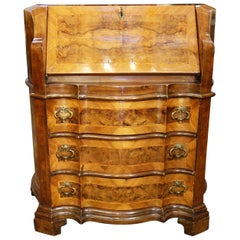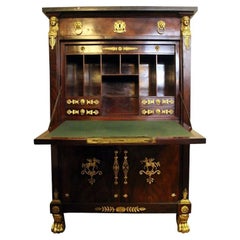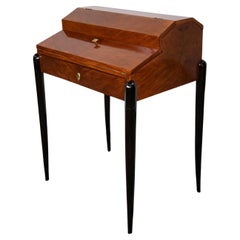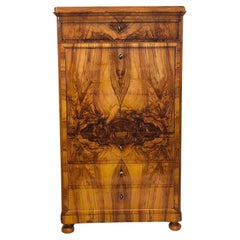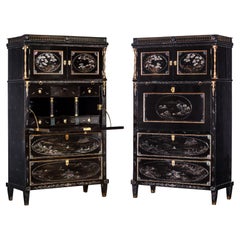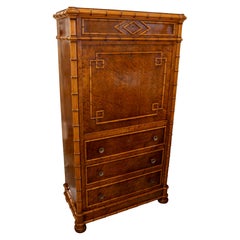Secretaires
Late 19th Century Italian Louis XIV Antique Secretaires
Walnut
1850s French Napoleon III Antique Secretaires
Granite, Brass, Ormolu
1930s French Art Deco Vintage Secretaires
Mahogany
Early 19th Century German Biedermeier Antique Secretaires
Pine, Walnut
Early 19th Century Japanese Antique Secretaires
Gold, Brass
19th Century German Aesthetic Movement Antique Secretaires
Wood
Mid-19th Century Danish Antique Secretaires
Wood, Mahogany
Early 19th Century French Empire Antique Secretaires
Metal, Brass, Bronze
1920s Italian Neoclassical Revival Vintage Secretaires
Walnut
1870s Italian Renaissance Antique Secretaires
Walnut
19th Century American Antique Secretaires
Mahogany
Mid-20th Century English Art Deco Secretaires
Walnut
Early 20th Century Swedish Art Deco Secretaires
Metal, Brass
20th Century Empire Secretaires
Bronze
Late 19th Century Italian Biedermeier Antique Secretaires
Fruitwood, Walnut, Wood
1930s British Mid-Century Modern Vintage Secretaires
Wood, Walnut
Mid-20th Century European Mid-Century Modern Secretaires
Stainless Steel
1960s Swedish Vintage Secretaires
Teak
1820s Swedish Biedermeier Antique Secretaires
Softwood
Mid-20th Century American French Provincial Secretaires
Paint
Early 19th Century English Georgian Antique Secretaires
Oak, Walnut
20th Century English Edwardian Secretaires
Hardwood
1810s French Empire Antique Secretaires
Marble, Bronze
19th Century Gustavian Antique Secretaires
Wood, Paint
Late 19th Century Spanish Baroque Antique Secretaires
Walnut
Early 19th Century German Empire Antique Secretaires
Birch, Fruitwood
20th Century Italian Georgian Secretaires
Brass
1930s French Art Deco Vintage Secretaires
Goatskin, Wood
19th Century Georgian Antique Secretaires
Mahogany
1940s American Georgian Vintage Secretaires
Mirror, Walnut
1920s French Art Deco Vintage Secretaires
Nutwood
1960s Dutch Vintage Secretaires
Wood
Early 1900s English Edwardian Antique Secretaires
Walnut
1950s European Mid-Century Modern Vintage Secretaires
Brass
Mid-19th Century German Biedermeier Antique Secretaires
Cherry, Walnut
Mid-19th Century French Louis Philippe Antique Secretaires
Brass
Late 19th Century French Louis XV Antique Secretaires
Brass, Ormolu
1830s German Biedermeier Antique Secretaires
Birch
19th Century German Baroque Antique Secretaires
Brass
1880s French Japonisme Antique Secretaires
Wood
Mid-20th Century Chinese Chippendale Secretaires
Brass
1960s French Mid-Century Modern Vintage Secretaires
Glass, Teak
Mid-19th Century Swedish Gustavian Antique Secretaires
Metal
Early 19th Century Austrian Biedermeier Antique Secretaires
Brass
20th Century American Mid-Century Modern Secretaires
Brass
19th Century French Neoclassical Antique Secretaires
Bronze
Late 19th Century French Louis XV Antique Secretaires
Marble, Bronze
19th Century Directoire Antique Secretaires
Marble, Brass
1820s American American Empire Antique Secretaires
Brass
19th Century French Louis XVI Antique Secretaires
Marble, Bronze, Gold Leaf
Mid-19th Century French Louis Philippe Antique Secretaires
Walnut
1850s Scandinavian Biedermeier Antique Secretaires
Walnut
Late 19th Century Italian Antique Secretaires
Hardwood
1960s American Chippendale Vintage Secretaires
Maple
Early 1800s European Empire Antique Secretaires
Mahogany
19th Century American Country Antique Secretaires
Mahogany
19th Century Hungarian Biedermeier Antique Secretaires
Walnut, Burl
Late 20th Century Philippine Modern Secretaires
Enamel
Antique, New and Vintage Secretaires
Your antique, new or vintage secretary desk has become the (chic) saving grace of the "new normal" at home.
Simply put, a secretary desk is a multifunctional piece of furniture with a hinged writing surface that folds open or drops down. When the leaf is folded out, small inner storage compartments — pigeonholes, cubbies, recesses or drawers — are revealed.
Traditionally, a secretary is composed of two parts — a chest of drawers on the bottom and a cabinet with shelves on the top. Taking its name from the French word for the piece, secrétaire, the secretary desk dates back to the 18th century, when Paris-based cabinetmaker Jean-François Oeben, known for his exquisite marquetry and clever mechanical desks, is thought to have invented the secrétaire à abbattant, or drop-leaf desk.
While the defining drop-down feature of the secretary desk has remained constant, the materials used, as well as its configuration, size and style have evolved over time.
At first, secretaries were typically made from exotic woods, like rosewood, tulipwood and kingwood; later, hardwoods like cherry, maple, oak and mahogany were more common. The desks also became lighter, with space carved out of the lower half for the writer’s feet or with drawers replaced by legs — making them more table-like.
When open, the secretary is a dynamic, versatile Wunderkammer. When closed, it’s a sophisticated, space-saving piece of furniture.
“A fine secretary with a good provenance adds stature and credence to its owner — it is a cornerstone piece,” says antiques dealer Stanley Weiss, who specializes in 18th- and 19th-century English and American furniture. “In this disposable world, fine furniture is always passed on and speaks to who its owner is.”
No matter what style or period you choose, and no matter how you decide to use it, the timeless, flexible secretary desk is bound to become an indispensable part of your daily routine.
Browse a range of antique and vintage secretary desks on 1stDibs, including mid-century modern secretaires, Georgian secretaires and others.
